
Figure 1. A late 1857 advertisement from Louis Mauss, noting that he had previously worked for Benjamin Pike & Sons in New York, and was selling eyeglasses, microscopes, magnifiers, and other optical and scientific instruments.
Louis Mauss, ca.1829 - 1862
by Brian Stevenson
last updated May, 2020
After learning the optical retail business with Benjamin Pike & Sons in New York City, Louis Mauss moved to Chicago in 1857 to open his own shop (Figure 1). As with his former employers, the majority of the microscopes and other apparatus sold by Mauss were imported from Europe (Figures 2-5). An 1859 newspaper article described Mauss as “a large dealer in optical instruments”, who was beginning to distribute locally-made microscopes (Figure 6). Mauss’ business was cut short by the US Civil War; serving as a Captain in the US Army, Mauss was killed at the Battle of Shiloh in April, 1862.
The Mauss optical business lasted for roughly 4 years, so he probably did not sell many microscopes. To date, two have been identified, both of French manufacture (Figures 2-5). One of them is identical to a drum-type compound microscope that was manufactured by Andres Krüss, of Hamburg, Germany, and is known to have been sold by Krüss and by Amédée Queslin of Paris, France (Figure 4). The short time span of Mauss’ business thus provides a date of manufacture for this model. The second is a model that has been attributed to Charles Chevalier (1804-1859) of Paris (Figure 5). If that attribution is correct, then the Mauss example demonstrates that they were produced toward the end of Chevalier’s life.

Figure 1.
A late 1857 advertisement from Louis Mauss, noting that he had previously worked for Benjamin Pike & Sons in New York, and was selling eyeglasses, microscopes, magnifiers, and other optical and scientific instruments.
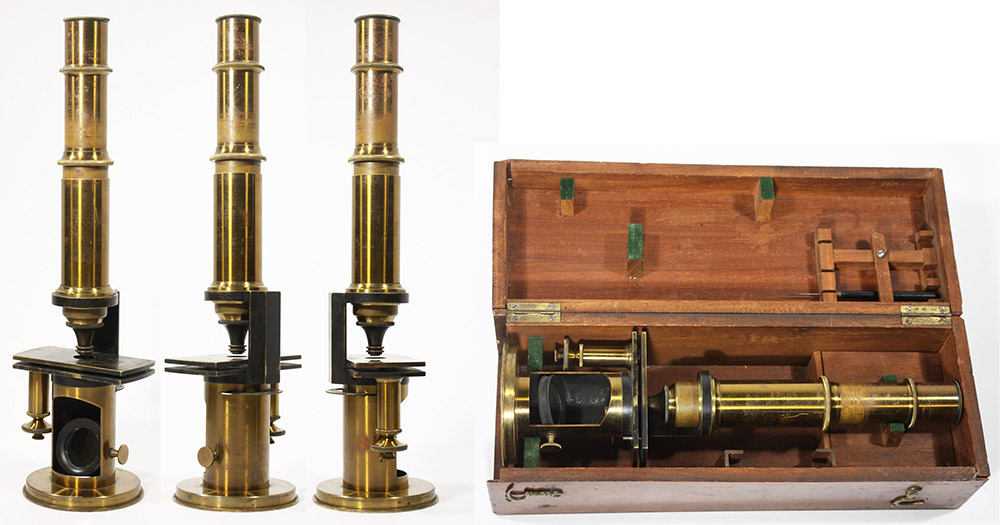
Figure 2.
An imported microscope that was retailed by Louis Mauss between 1857 and 1861.
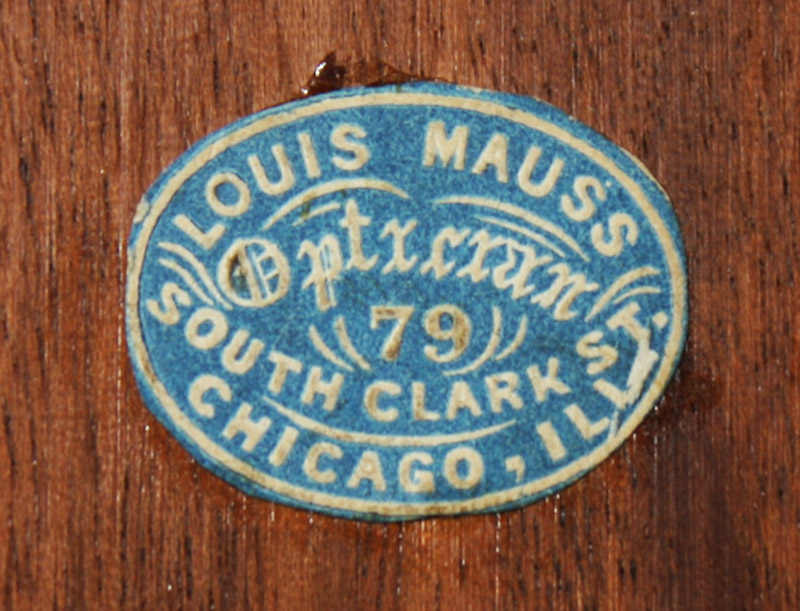
Figure 3.
Louis Mauss’ trade label, which is glued to the inside the inner compartment of the microscope cabinet shown in Figure 2.

Figure 4.
Four identical microscopes, undoubtedly all from the same manufacturer.
(A) Sold by Louis Mauss, Chicago (Figure 2, above).
(B) Sold by Amédée Queslin, Paris, France. His name is engraved on the body tube.
(C) Sold by Andres Krüss, Hamburg, Germany. It is inscribed with his name and serial number 191. Adapted from https://www.musoptin.com/item/trommelmikroskop-a-kruess-191-um-1858.
(D) Also sold by Andres Krüss, engraved with serial number 260. Note that the case is identical to that of the Mauss microscope (Figure 2). Adapted from http://www.antique-microscopes.com/photos/kruss.htm.
(E) Ca. 1858 advertisement from Andres Krüss, showing this model of microscope. Adapted from https://www.musoptin.com/item/trommelmikroskop-a-kruess-191-um-1858
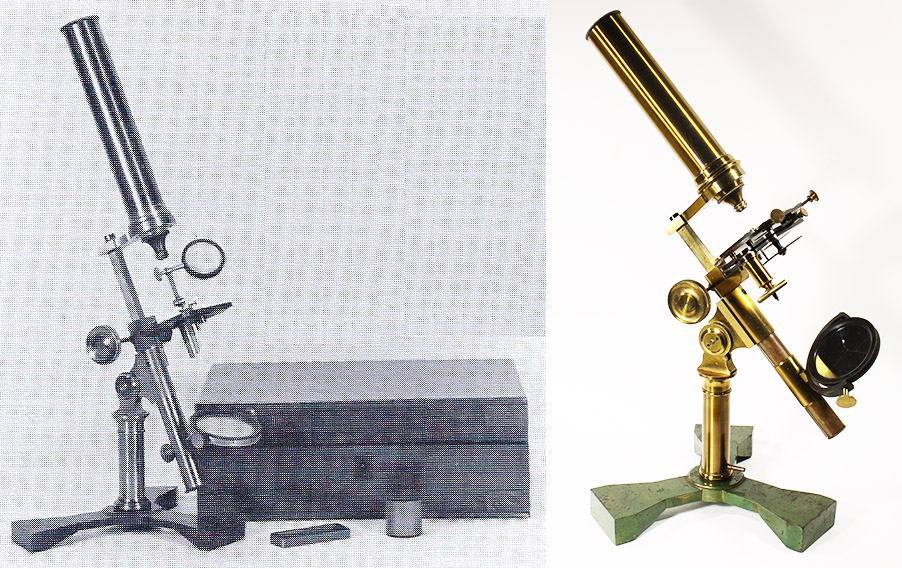
Figure 5.
A pair of identical microscopes. The left one was sold by Louis Mauss. The example on the right is unsigned. This design is attributed to Charles Chevalier (1804-1859) of Paris. Adapted for nonprofit, educational purposes from an auction booklet.
Ages listed on government forms indicate that Louis Mauss was born in Hesse (Germany) in 1829 or 1830. He is probably the “L. Mauss” who arrived in New York City on May 17, 1850, coming from Bremen. Presumably, he began working for Benjamin Pike & Sons soon after his arrival.
Mauss probably moved to Chicago during mid- to late-1857. The 1860 census shows that he and his wife, Mary, had a 3 year-old child who was born in New Jersey. Advertisements for Mauss’ optical shop at 79 Clark Street, Chicago, are known from as early as October 30, 1857.
An 1860 advertisement states that Mauss was then manufacturing barometers, and had won awards at state and national exhibitions (Figure 8).
The US Civil War broke out in April, 1861. That August, The Chicago Tribune reported, “Capt. Louis Mauss has been authorized by Gen. Fremont to fill up his company of sharp-shooters and is assured that when full they will be accepted”. It is not clear why Mauss was commissioned as an officer - he may have had military experience in Germany, or it might be due to experience with running a large business.
He formally enlisted on September 1, joining the 43rd Illinois Infantry. That regiment was primarily composed of German immigrants.
In the spring of 1862, Mauss’ regiment was camped near Pittsburg Landing, Tennessee. On the morning of April 6, they were attacked by a Confederate army, beginning the Battle of Shiloh. From the Report of the Adjutant General, “On the morning of Sunday, April 6th, Colonel Raith heard the sound of battle, had the Regiment assembled, the tents taken down, the wagons loaded, and the Regiment paraded on the color line. He had sent Lieutenant Colonel Engelmann to General McClernand to inform him of the approaching battle, Where Lieutenant Colonel Engelmann was instructed to tell Colonel Reardon, of the Twenty-ninth Illinois, to assume command of the Brigade, as General L.F. Ross had gone to Illinois on furlough. Colonel Reardon being sick, the command of the Brigade devolved upon Colonel Julius Raith. His own Regiment, the Forty-third, was the only one ready for action. The staff officers of the Brigade were half a mile away, at the Brigade headquarters. Beside the mounted officers of his own Regiment, he had no assistance in turning out the other regiments of the Brigade. He ordered Colonel Engelmann to turn out the Forty-ninth, which was to the left of the Forty-third, but the men of that Regiment could only seize their muskets and accoutrements when the enemy was upon them. They had no time to form line. Lieutenant Colonel Engelmann now had to assume command of the Forty-third, which for a long time alone supported the Waterhouse Battery and with it offered a stubborn resistance to the enemy, leaving in this first position 36 of its number dead, whilst many had been carried severely wounded to the rear. (See Greeley's history of this battle.) The Forty-third next took position on the Purdy road, with McClernand's Division. Here Colonel Raith was mortally wounded, dying on the 11th. This line giving Way, the Forty-third was next assigned a position by Captain Hammond, of General Sherman's staff, in a compact line of troops facing the Purdy Roads. This line also giving way, the Forty-third took a position with the Twentieth Illinois. All other Union troops having disappeared, the Forty-third slowly fell back to a position facing towards the west, an open field, and immediately to the left of the camp of the Ninth Illinois. About 4:30 o'clock Generals Grant, Sherman and McClernand came up, with many of their staff, and inspected the position of the Forty-third. They soon sent up troops from the direction of the river, and formed them on the line held by the Forty-third; the Forty-sixth Illinois being formed on the right of the Forty-third, also facing to the West. A battery was placed on the left of the Forty-third, firing to the southwest. It was supported by the Thirteenth Missouri (subsequently called the Twenty-second Ohio), which faced to the south, being part of a compact line of infantry and artillery from there to the Tennessee, which the Union troops held during the night. In every position held by the Forty-third during the day it had left its dead and wounded, who, being carried off by the enemy, were the only men who had to be reported missing. The advance the next day was slow, and it was at about 4 o'clock P.M. when what was left of the Forty-third again stacked arms in front of its camp. Out of a total of 500 taken into action, it had lost 206, of whom 49 had been left dead on the field. The officers killed were Captains Louis Mauss, Franz Grimm, Chaplain J. L. Walther, Lieutenants John Oppendick, John Lindroth and Henry Sacker. Mortally wounded were Colonel Raith and Captain Olof. S. Edvall, and severely wounded Captain William Ehrhard, John Tobien and Charles Stephani and two Lieutenants”.
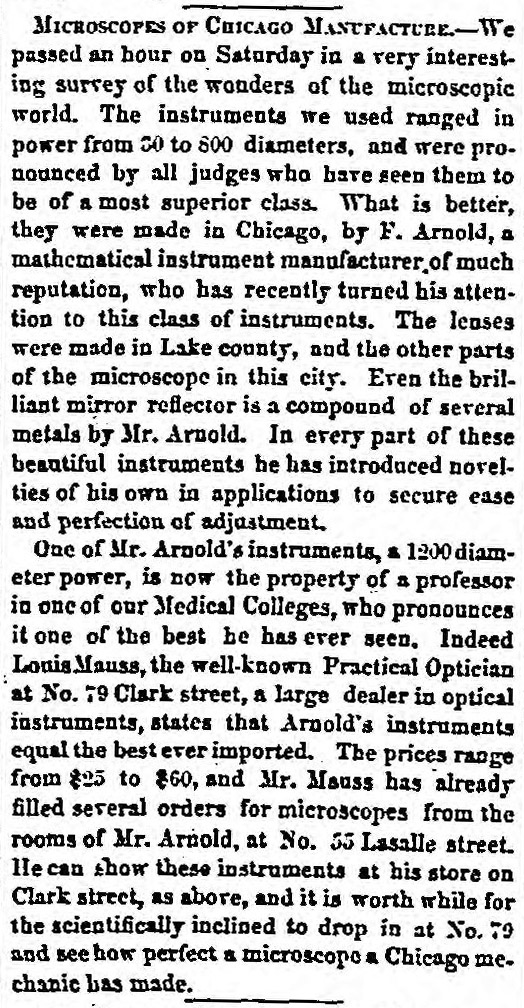
Figure 6.
An article from “The Chicago Press and Tribune”, December 26, 1859. It describes Louis Mauss as a “well-known practical optician” and “a large dealer in optical instruments”. The focus of the article is microscopes being made in Chicago by Francis Arnold. I have not found further information on Arnold’s microscopes, but did locate images of some of his surveying equipment, http://www.surveyhistory.org/f__arnold_&_co_1.htm.
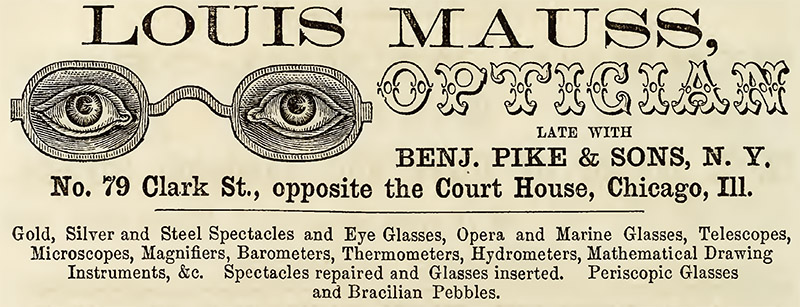
Figure 7.
An 1860 advertisement from “The Illinois State Business Directory”.
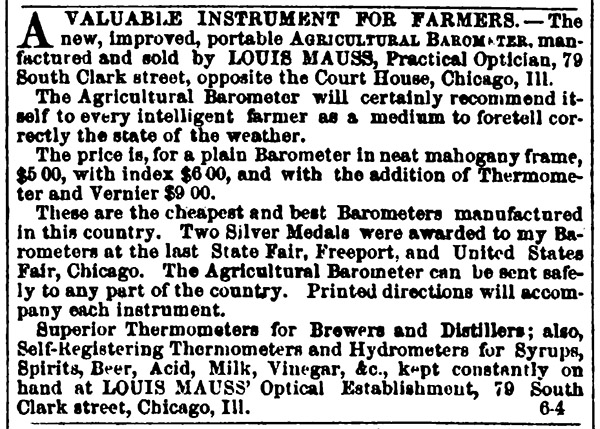
Figure 8.
An 1860 advertisement from “The Prairie Farmer”. Mauss stated that he was then producing barometers, and had won awards for them.
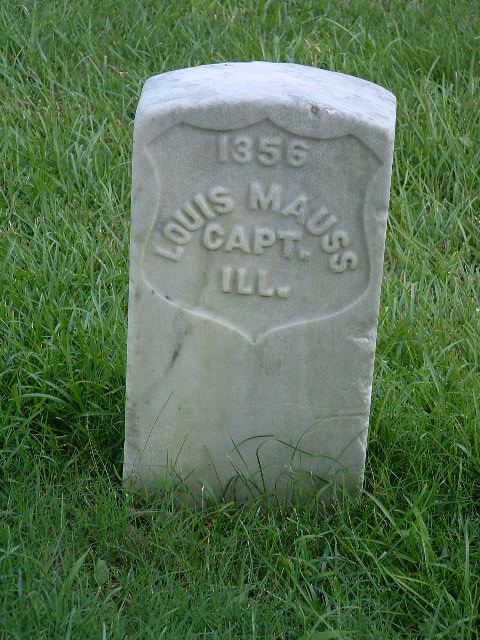
Figure 9.
Louis Mauss’ grave at the Shiloh National Cemetery.
Acknowledgements
Thank you to Allan Wissner for directing me toward Andres Krüss and for permission to use images from http://www.antique-microscopes.com, to Timo Mappes for permission to use images from https://www.musoptin.com, and to Joe Zeligs for helpful comments and for bringing a second Mauss microscope to my attention.
Resources
Chicago Daily Tribune (1861) Advertisement from Louis Mauss, October 14, page 3
Chicago Press and Tribune (1859) Advertisement from Louis Mauss, June 3
Chicago Tribune (1861) “Capt. Louis Mauss has been authorized by Gen. Fremont to fill up his company of sharp-shooters and is assured that when full they will be accepted”, August 26
Find-a-Grave (accessed May, 2020) https://www.findagrave.com/memorial/9005217/louis-mauss
G.W. Hawes’ Illinois State Gazetteer and Business Directory for 1858 and 1859 (1858) “Opticians … Mauss Louis, 79 Clark St.”, page 54
Illinois State Business Directory (1860) Advertisement from Louis Mauss, page 465
Madison Daily State Journal (1857) Advertisement from Louis Mauss, October 30
Prairie Farmer (1860) Advertisement from Louis Mauss, Vol. 21, page 126
Report of the Adjutant General (1862) Illinois Military and Naval Department, Vol. 3, pages 276-277
US census and other records, accessed through ancestry.com
Western Railroad Gazette (1859) Advertisement from Louis Mauss, Vol. 3, July 23, page 4